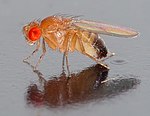Insects (from Latin insectum, a calque of Greek ἔντομον [éntomon], "cut into sections") are a class within the arthropods that have a chitinous exoskeleton, a three-part body (head, thorax, and abdomen), three pairs of jointed legs, compound eyes, and two antennae. They are among the most diverse group of animals on the planet and include more than a million described species and represent more than half of all known living organisms. The number of extant species is estimated at between six and ten million, and potentially represent over 90% of the differing metazoan life forms on Earth.
Insects typically move about by walking, flying or occasionally swimming. Because it allows for rapid yet stable movement, many insects adopt a tripedal gait in which they walk with their legs touching the ground in alternating triangles. Insects are the only invertebrates to have evolved flight. Many insects spend at least part of their life underwater, with larval adaptations that include gills and some adult insects are aquatic and have adaptations for swimming. Some species, like water striders, are capable of walking on the surface of water. (Full article...)
